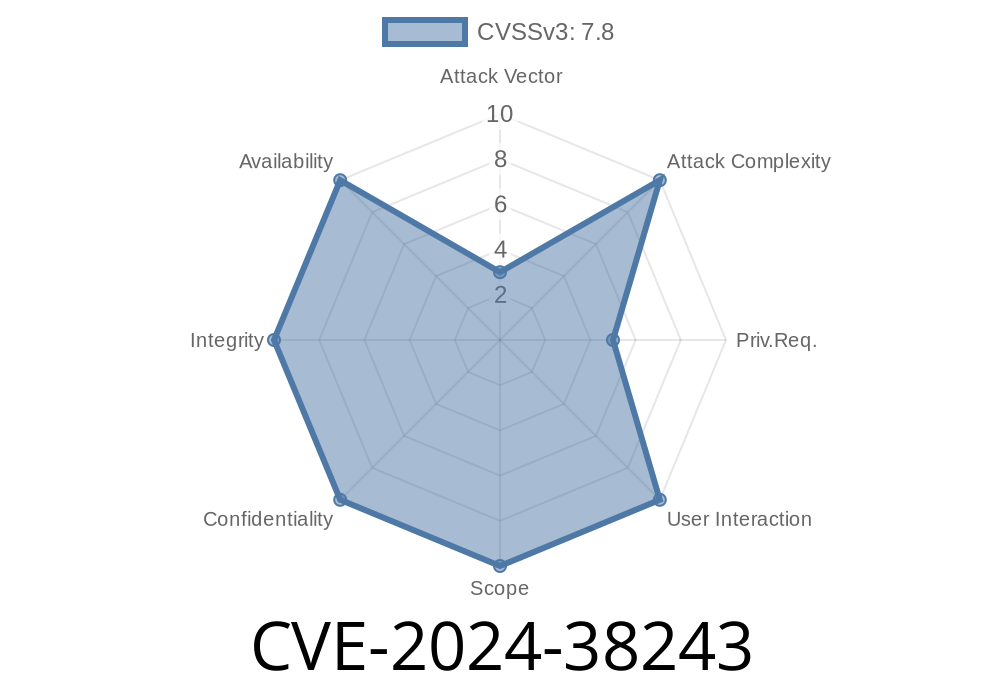A newly discovered vulnerability tracked as CVE-2024-38243 made the security headlines this month. Found in Microsoft Windows’ Kernel Streaming (KS) service driver, this flaw allows attackers to elevate their privilege on affected systems — essentially letting an attacker gain system-level rights by exploiting the vulnerable driver. In this post, I’ll break down in simple terms what this CVE means, demonstrate with code snippets, link to original references, walk through a potential exploit scenario, and show you what you can do to stay safe.
What is CVE-2024-38243?
CVE-2024-38243 is an “Elevation of Privilege” (EoP) vulnerability located in the Kernel Streaming (KS) service driver, a piece of Windows that handles real-time audio and video streaming by interfacing user-mode applications with kernel mode hardware.
A flaw in how the KS driver handles certain input/output control (IOCTL) requests allows a non-admin user to escalate privileges, possibly to SYSTEM.
Microsoft’s official advisory:
https://msrc.microsoft.com/update-guide/vulnerability/CVE-2024-38243
Who’s Affected?
Most modern Windows desktop and server installations are affected. The root issue lies deep in the Kernel Streaming service, which is present in a wide range of Windows versions, including:
Windows Server 2016, 2019, 2022
Microsoft has patched the issue in July 2024 Patch Tuesday update.
How Bad is It?
If an attacker gains code execution on your machine (for example, via a phishing attack or a malicious download), they can leverage this vulnerability to elevate their rights from a limited user to SYSTEM, the most powerful account on Windows. This makes *post-exploitation* actions, like disabling antivirus, installing persistent malware, or stealing sensitive data, all possible.
Where’s the Vulnerability?
The core of the issue is in the way the KS.sys driver handles certain IOCTLs without sufficient checks. By crafting a special request, attackers can cause the driver to overwrite memory in a controlled way — leading to arbitrary kernel-mode writes.
Key bug:
Untrusted data from user space is mishandled when processing device control requests, allowing an attacker to perform a “write-what-where” condition.
Here’s a minimal pseudo-code to demonstrate how a normal user process might trigger the bug
#include <windows.h>
#include <stdio.h>
#define KS_DEVICE "\\\\.\\KS" // Kernel Streaming device
int main() {
HANDLE hDevice = CreateFileA(
KS_DEVICE,
GENERIC_READ | GENERIC_WRITE,
, NULL,
OPEN_EXISTING,
FILE_ATTRIBUTE_NORMAL,
NULL
);
if (hDevice == INVALID_HANDLE_VALUE) {
printf("[-] Unable to open device: %d\n", GetLastError());
return 1;
}
// Craft the malicious IOCTL input buffer
BYTE InputBuffer[x100] = { /* Attacker-defined data here */ };
DWORD bytesReturned;
BOOL result = DeviceIoControl(
hDevice,
xAA013044, // IOCTL vulnerable code (example for illustration)
InputBuffer,
sizeof(InputBuffer),
NULL,
,
&bytesReturned,
NULL
);
if(result) {
printf("[+] IOCTL succeeded, system may be vulnerable.\n");
} else {
printf("[-] IOCTL error: %d\n", GetLastError());
}
CloseHandle(hDevice);
return ;
}
Disclaimer:
This is a simplified PoC and does not fully exploit the vulnerability. The full exploit would involve advanced techniques, such as crafting the input buffer to overwrite function pointers or system token privileges.
Use DeviceIoControl on the \\.\KS driver with a malicious input.
2. Trigger a write-what-where scenario, which essentially lets them write arbitrary data wherever they want in memory.
What Does The Exploit Look Like in Practice?
A working exploit would be highly valuable to attackers and is unlikely to be widely available. However, exploitation is considered straightforward with local access due to the driver’s accessible interface.
Community discussions:
- https://github.com/rapid7/metasploit-framework/issues/19457
- https://bugs.chromium.org/p/project-zero/issues/detail?id=2451
Restrict local access on endpoints where possible.
3. Monitor event logs for strange behavior around audio/video services.
4. Use endpoint protection — many EDR/AVs now detect exploitation patterns against drivers.
Additional References
- Microsoft Security Advisory: CVE-2024-38243
- Windows Kernel Streaming Architecture
- Project Zero: Windows Kernel Exploitation Techniques
- Securelist: A guide to driver exploitation for beginners
Conclusion
CVE-2024-38243 is dangerous because it’s easy to exploit once someone has local access, and because the vulnerable surface (the KS sys driver) is always present on modern Windows systems. If you haven’t patched your Windows machines since July 2024, do it now!
Stay up to date, monitor for signs of exploitation, and remember: driver vulnerabilities are a favorite tool of attackers for a reason.
Timeline
Published on: 09/10/2024 17:15:28 UTC
Last modified on: 10/09/2024 01:26:28 UTC
